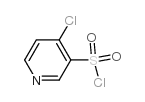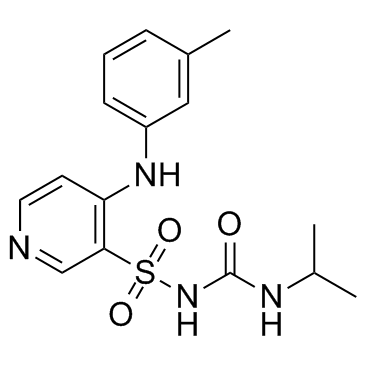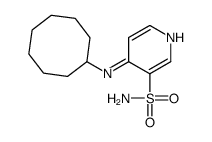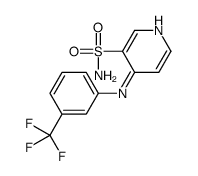4-chlorpyridin-3-sulfonamid
Modify Date: 2024-01-02 11:42:11

4-chlorpyridin-3-sulfonamid structure
|
Common Name | 4-chlorpyridin-3-sulfonamid | ||
|---|---|---|---|---|
| CAS Number | 33263-43-3 | Molecular Weight | 192.623 | |
| Density | 1.6±0.1 g/cm3 | Boiling Point | 380.4±52.0 °C at 760 mmHg | |
| Molecular Formula | C5H5ClN2O2S | Melting Point | 150-155 °C | |
| MSDS | USA | Flash Point | 183.9±30.7 °C | |
| Name | 4-Chloro-3-pyridinesulfonamide |
|---|---|
| Synonym | More Synonyms |
| Density | 1.6±0.1 g/cm3 |
|---|---|
| Boiling Point | 380.4±52.0 °C at 760 mmHg |
| Melting Point | 150-155 °C |
| Molecular Formula | C5H5ClN2O2S |
| Molecular Weight | 192.623 |
| Flash Point | 183.9±30.7 °C |
| Exact Mass | 191.976028 |
| PSA | 81.43000 |
| LogP | -0.28 |
| Vapour Pressure | 0.0±0.9 mmHg at 25°C |
| Index of Refraction | 1.592 |
| Water Solubility | soluble |
Synonym: Section 2 - COMPOSITION, INFORMATION ON INGREDIENTS
Risk Phrases: 20/21/22 Section 3 - HAZARDS IDENTIFICATION EMERGENCY OVERVIEW
Harmful by inhalation, in contact with skin and if swallowed. Potential Health Effects Eye: May cause eye irritation. Skin: May cause skin irritation. Harmful if absorbed through the skin. Ingestion: Harmful if swallowed. May cause irritation of the digestive tract. Inhalation: Harmful if inhaled. May cause respiratory tract irritation. Chronic: Not available. Section 4 - FIRST AID MEASURES Eyes: Flush eyes with plenty of water for at least 15 minutes, occasionally lifting the upper and lower eyelids. Get medical aid. Skin: Get medical aid. Flush skin with plenty of water for at least 15 minutes while removing contaminated clothing and shoes. Ingestion: Get medical aid. Wash mouth out with water. Inhalation: Remove from exposure and move to fresh air immediately. If not breathing, give artificial respiration. If breathing is difficult, give oxygen. Get medical aid. Notes to Physician: Section 5 - FIRE FIGHTING MEASURES General Information: As in any fire, wear a self-contained breathing apparatus in pressure-demand, MSHA/NIOSH (approved or equivalent), and full protective gear. Extinguishing Media: DO NOT USE WATER! Use dry powder or carbon dioxide. Section 6 - ACCIDENTAL RELEASE MEASURES General Information: Use proper personal protective equipment as indicated in Section 8. Spills/Leaks: Vacuum or sweep up material and place into a suitable disposal container. Section 7 - HANDLING and STORAGE Handling: Avoid breathing dust, vapor, mist, or gas. Avoid contact with skin and eyes. Storage: Store in a cool, dry place. Store in a tightly closed container. Section 8 - EXPOSURE CONTROLS, PERSONAL PROTECTION Engineering Controls: Use adequate ventilation to keep airborne concentrations low. Exposure Limits CAS# 33263-43-3: Personal Protective Equipment Eyes: Not available. Skin: Wear appropriate protective gloves to prevent skin exposure. Clothing: Wear appropriate protective clothing to prevent skin exposure. Respirators: Follow the OSHA respirator regulations found in 29 CFR 1910.134 or European Standard EN 149. Use a NIOSH/MSHA or European Standard EN 149 approved respirator if exposure limits are exceeded or if irritation or other symptoms are experienced. Section 9 - PHYSICAL AND CHEMICAL PROPERTIES Physical State: Powder Color: off-white Odor: Not available. pH: Not available. Vapor Pressure: Not available. Viscosity: Not available. Boiling Point: Not available. Freezing/Melting Point: Not available. Autoignition Temperature: Not available. Flash Point: Not available. Explosion Limits, lower: Not available. Explosion Limits, upper: Not available. Decomposition Temperature: Solubility in water: Soluble. Specific Gravity/Density: Molecular Formula: C5H5ClN2O2S Molecular Weight: 192.5602 Section 10 - STABILITY AND REACTIVITY Chemical Stability: Not available. Conditions to Avoid: Incompatible materials, excess heat. Incompatibilities with Other Materials: Oxidizing agents. Hazardous Decomposition Products: Hydrogen cyanide, carbon monoxide, oxides of nitrogen, carbon dioxide. Hazardous Polymerization: Has not been reported Section 11 - TOXICOLOGICAL INFORMATION RTECS#: CAS# 33263-43-3 unlisted. LD50/LC50: Not available. Carcinogenicity: 4-Chloro-3-pyridinesulfonamide - Not listed by ACGIH, IARC, or NTP. Section 12 - ECOLOGICAL INFORMATION Other No information available. Section 13 - DISPOSAL CONSIDERATIONS Dispose of in a manner consistent with federal, state, and local regulations. Section 14 - TRANSPORT INFORMATION IATA No information available. IMO No information available. RID/ADR No information available. Section 15 - REGULATORY INFORMATION European/International Regulations European Labeling in Accordance with EC Directives Hazard Symbols: XN Risk Phrases: R 20/21/22 Harmful by inhalation, in contact with skin and if swallowed. Safety Phrases: S 36/37 Wear suitable protective clothing and gloves. WGK (Water Danger/Protection) CAS# 33263-43-3: 1 Canada None of the chemicals in this product are listed on the DSL/NDSL list. CAS# 33263-43-3 is not listed on Canada's Ingredient Disclosure List. US FEDERAL TSCA CAS# 33263-43-3 is not listed on the TSCA inventory. It is for research and development use only. SECTION 16 - ADDITIONAL INFORMATION N/A |
| Hazard Codes | Xn:Harmful; |
|---|---|
| Risk Phrases | R22;R36/37/38 |
| Safety Phrases | S36/37 |
| RIDADR | 2811 |
| Packaging Group | III |
| HS Code | 2935009090 |
| Precursor 3 | |
|---|---|
| DownStream 7 | |
| HS Code | 2935009090 |
|---|---|
| Summary | 2935009090 other sulphonamides VAT:17.0% Tax rebate rate:9.0% Supervision conditions:none MFN tariff:6.5% General tariff:35.0% |
| 4-CHLORO-3-PYRIDINESULFAMIDE |
| 4-Chloropyridine-3-Sulfamide |
| 4-Choropyridine-3-sulphonamide. 4-chloro-3-pyridinesulfonamide |
| 4-Choropyridine |
| 4-chloro-pyridine-3-sulphonamide |
| EINECS 251-434-4 |
| 4-Chloropyridin-3-sulfonamide |
| 4-Chloropyridine-3-sulfonamide |
| 4-chlorpyridin-3-sulfonamid |
| 4-CHOROPYRIDINE-3-SULPHONAMIDE |
| 4-Chloropyridine-sulphonamide |
| MFCD03093286 |
| 4-chloro-pyridine-3-sulfonic acid amide |
| 3-Pyridinesulfonamide, 4-chloro- |
| 4-chloropyridin-3-yl-sulfonamide |
| 3-PYRIDINE-4-CHLOROSULFONAMIDE |
| 4-Chloro-3-Sulfamoylpyridine |
| 4-Chloro-3-pyridinesulfonamide |
 CAS#:33263-44-4
CAS#:33263-44-4 CAS#:51498-37-4
CAS#:51498-37-4 CAS#:626-64-2
CAS#:626-64-2 CAS#:56211-40-6
CAS#:56211-40-6 CAS#:72811-73-5
CAS#:72811-73-5 CAS#:75903-62-7
CAS#:75903-62-7![4-[(3-Methylphenyl)amino]-3-pyridinesulfonamide Hydrochloride structure](https://image.chemsrc.com/caspic/119/160822-47-9.png) CAS#:160822-47-9
CAS#:160822-47-9 CAS#:76287-10-0
CAS#:76287-10-0 CAS#:58155-57-0
CAS#:58155-57-0 CAS#:38030-43-2
CAS#:38030-43-2
